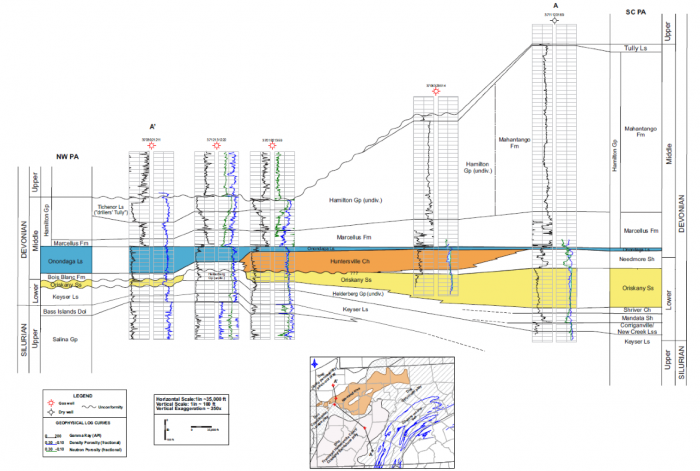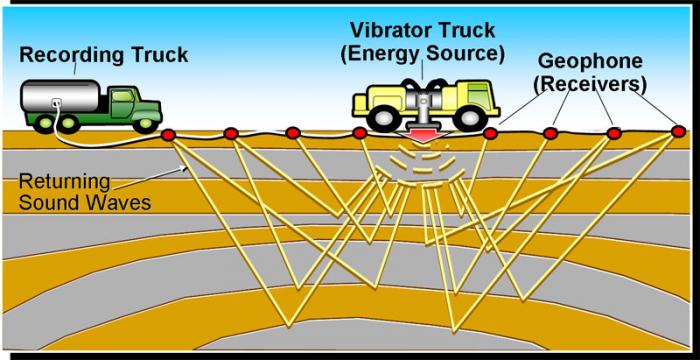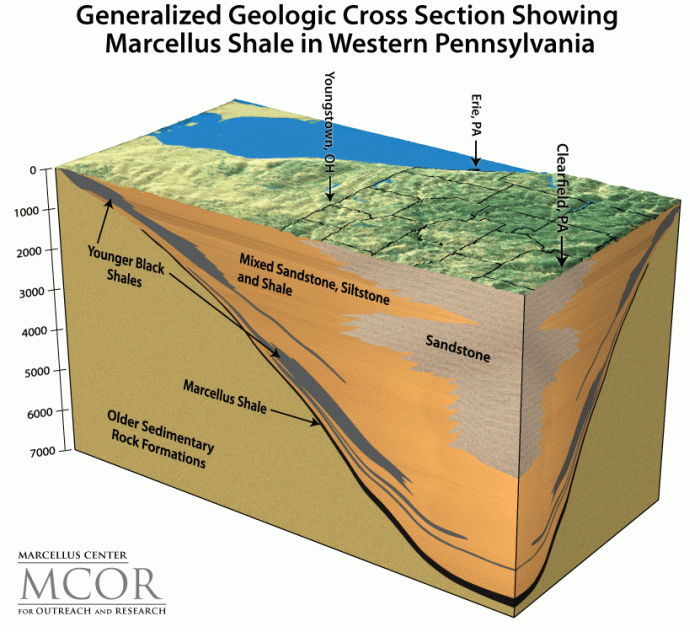How do geologists find oil and natural gas?
Geologists use a lot of the information that has been presented to you in this module to locate oil and natural gas-bearing rocks. First, geologists think about where oil and gas form, typically in rocks like shale, which form in deep marine environments. So, a geologist would start out by looking for depositional environments that would contain organic-rich shale. There are a few ways to go about this.
One way is to look at the rocks exposed at the surface of the earth. By making a geologic map and extrapolating what we find at the surface to some depth into the Earth(typically a mile or more), we can form a reasonable guess about what rocks are below and at what depth they occur. One problem with this is that oil and gas can be far beneath the surface, and it’s possible that faults or folds could exist below that we cannot see at the surface. Here’s an example of a geologic cross-section that was made based on the data collected from the surface along with a combination of drilling cores samples, borehole geophysical data (such as gamma ray, density, and porosity logs) and seismic data.

Drilling cores can be thousands of feet long, and provide a snapshot of what exists beneath a particular point. By drilling several cores miles apart, geologists can correlate the rock units and create an image of what exists below the surface in between the cores. Combining this information with rocks exposed at the surface, which can give clues about rock orientations below, can be a powerful tool in locating oil and gas-bearing formations. In areas where conventional wells were historically drilled, these older well logs can be used to identify and correlate the depths and thicknesses of shale formations, which can be very cost effective rather than drilling dedicated assessment wells into the shale. Once you have an idea of what the big picture is, you can figure out where the particular rock type you’re looking for might be.
A third way to get an idea of what is below the surface is to run a seismic survey. Remember from the very beginning of the geology lesson that a seismologist is a geologist who studies earthquakes and the properties of elastic waves through the earth. Earthquakes create natural waves that move through the earth, and by recording them seismologists can study the earthquake itself in addition to the properties of the different layers of the earth. It’s in large part thanks to earthquakes that we know the outer core is liquid!
In a seismic survey, a human-generated wave is sent through the earth using a thumper truck, dynamite, or simply a hammer (the more energy in the wave, the farther it will go before dissipating). Just as P-waves can pass through the entirety of the earth (if they have enough energy) and S-waves cannot pass through liquids, different rocks interact with the waves caused by thumper trucks in different ways. Depending on the properties of the rock, the thumper-truck wave can either pass through, be reflected, or some combination of the two. In a seismic survey, there will be a point source for the wave (the place the wave comes from) and a number of ‘geophones’ set up around the point source that ‘listen’ for the reflections of the waves when they come back to the surface. The length of time it takes for the wave to return depends on the properties of the rock that reflects it and how deep the rock is. Seismic surveys can’t tell you precisely what types of rock are below the surface, but they can give you an idea of how deep and thick a formation as well as the structural geology below the surface.

Each of these methods for identifying what’s going on beneath the surface of the earth comes with its own set of uncertainties. Figuring out what’s going on beneath the surface is a little like putting together a puzzle while blindfolded: we only know the shapes of the pieces we touch, and we can’t see the whole picture. So to get the best idea of what is occuring in the subsurface is to use all the tools and technology at our disposal in order to develop a conceptual model based on what we know. Even then, the interpretation could be missing information or could be wrong. Seismic data that is correlated with a core or other geophysical data allows geologists can extend their interpretation of the core to get a much bigger picture without having to do more drilling. The figure below is a generalized, conceptual cross-section of the Marcellus shale's distribution in Western Pennsylvania.
